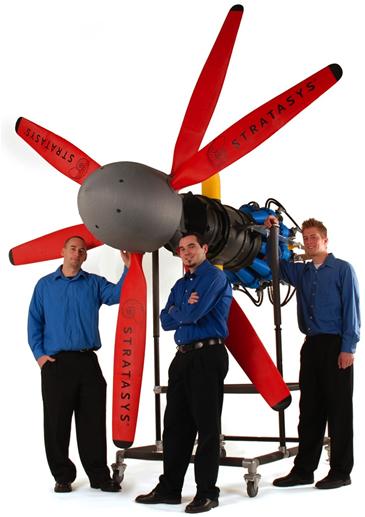3-D Printing on a Gigantic Scale
Like computers in their early days, 3D printing is one of those things that drifts in and out of the news cycle. But it is one of those quietly revolutionary technologies that could eventually be fundamental to how we live and work.
Lately, Maker Faires and the open-source MakerBot 3D printer kits (which cost less than $1,000) have highlighted the accessibility of this emerging technology–think of them as the Altair 8800 computers (one of the first widely available home PCs) of the modern age.

But if you want to find out where this technology is taking us, aside from printing in ever more durable materials, you have to scale up your expectations.
Nino Caldarola, an application specialist at Autodesk-affiliated Imaginit Technologies, decided to push the limits of 3D printing technology by fabricating an entire aircraft turboprop engine.
The design required 1400 parts, only a small fraction of which he ultimately printed out - the 200 or so that are visible on the outside of the engine.
What made his project possible was the industrial-scale 3D printing service Fortus, which uses 3D printers made by a company called Stratasys.
The entire engine was made from fused ABS plastic – commonly found in everything from plastic pipes to plastic musical instruments like recorders – and it really works. Or at least, it really turns.
Building the real thing with a 3D printer would be impossible, of course, and it’s not clear it will ever be possible to “print” the sophisticated, difficult-to-manufacture metal alloys required for aerospace applications. Which is why 3D printing most definitely does not herald the arrival of Star Trek-style “replicators.”
But not everything we use has to be as tough as an engine. Aside from the fact that 3D printing makes prototyping so much easier than before, when it comes to furniture, decorations, and maybe even the body panels and many of the key parts of kit cars, printing with plastic or sintered metal might be fine. The key is that 3D printers need to be bigger than the PCs to which they’re connected: in the real world, size matters.
Keep Reading
Most Popular
Large language models can do jaw-dropping things. But nobody knows exactly why.
And that's a problem. Figuring it out is one of the biggest scientific puzzles of our time and a crucial step towards controlling more powerful future models.
How scientists traced a mysterious covid case back to six toilets
When wastewater surveillance turns into a hunt for a single infected individual, the ethics get tricky.
The problem with plug-in hybrids? Their drivers.
Plug-in hybrids are often sold as a transition to EVs, but new data from Europe shows we’re still underestimating the emissions they produce.
Google DeepMind’s new generative model makes Super Mario–like games from scratch
Genie learns how to control games by watching hours and hours of video. It could help train next-gen robots too.
Stay connected
Get the latest updates from
MIT Technology Review
Discover special offers, top stories, upcoming events, and more.